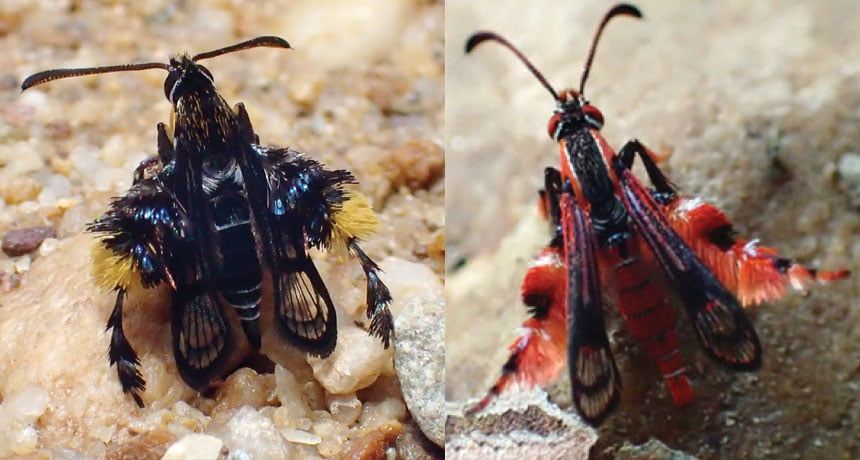The clearwing moths are an interesting subset of the enormous insect kingdom. These enigmatic animals can so convincingly imitate bees and wasps in flight that they look virtually see-through. The fascinating world of clearwing moths is the subject of this article, which delves into their anatomy, behaviour, and ecological relevance.
What is a Clearwing Moth?
The clearwing moth, or hummingbird moth, or sphinx moth, is a member of the family Sesiidae. They may be found all throughout the world, from North America and Europe to Asia and beyond. The translucent wings that give these fascinating insects their common name are the result of a lack of scales in certain places.
Physical Characteristics of Clearwing Moths
Clearwing moths are tiny insects, seldom exceeding 2 inches in length. As the name implies, some parts of their wings do not contain the typical powdery scales found on moths. These see-through areas let light through, giving the impression that the air is translucent.
As a cunning defence strategy against predators, clearwing moths have stocky bodies that resemble those of bees and wasps. Some species are brightly coloured in yellow, orange, or red, while others take on more subdued tones of brown and grey.
Habitat and Distribution
It’s not uncommon to spot a clearwing moth everywhere from a thick woodland to a flower garden. Since nectar from flowers is a vital food source for both adults and larvae, they gravitate towards such places. Clearwing moths are found in many different habitats across the world because various species have adapted to their conditions.
Lifecycle of Clearwing Moths
There are four phases in a clearwing moth’s life cycle: egg, larva, pupa, and adult.
5.1. Egg Stage
The female lays her eggs on or near a host plant, which will later be consumed by the hatching larvae.
5.2. Larval Stage
After hatching, the caterpillar-like larvae (sometimes called borers) dig into the host plant to feed on its interior tissues. These larvae have multiple developmental stages called “instars” before reaching adulthood.
5.3. Pupal Stage
After developing through its larval stage, a caterpillar will spin a cocoon on the host plant and undergo metamorphosis into a pupa.
5.4. Adult Stage
When a clearwing moth emerges from its cocoon, it begins a brief but critical period of its existence during which it must locate a mate and secure the survival of its species.
Behavior and Adaptations
During the day is when you’re most likely to spot a clearwing moth because these insects are strictly diurnal. Their nectar-feeding habits and accidental pollen transfer across plants make them effective pollinators, so this behaviour makes sense. In order to reach the nectar in deep blossoms, they have developed into skilled fliers capable of hovering like hummingbirds.
Clearwing moths use a clever sort of mimicry to ward off predators. They repel would-be predators by dressing up like bees or wasps, which gives the impression of a strong defence system.
Importance in Ecosystems
The clearwing moth is an important ecological player because of its role as a pollinator. They unwittingly help cross-pollinate plants as they search for nectar. This procedure helps many plant species to endure by increasing their genetic diversity. In addition, they provide nutrition for a wide variety of insectivores, strengthening the web of life in those regions.
Clearwing Moths and Pollination
Clearwing moths and the plants they visit are a great example of a mutualistic interaction. Since the moths feed on the nectar, the flowers benefit, and the plants reap the rewards of accidental pollen transfer.
Threats and Conservation
Clearwing moths play an important role in ecosystems, yet they are under danger for several reasons. Destroying their habitat, using pesticides, and global warming all pose serious threats to their continued existence. These beautiful insects are vital to maintaining the delicate balance of the natural world, thus it is essential that conservation measures be made to keep them safe.
Interesting Facts about Clearwing Moths
- Clearwing moths are sometimes mistaken for bees or wasps due to their striking resemblance.
- Some species of clearwing moths are migratory, traveling long distances in search of suitable habitats.
- The caterpillar stage is the most extended phase of their life cycle, lasting several weeks or even months.
- Clearwing moths can produce ultrasonic sounds, which they use during courtship rituals.
The Relationship with Humans
Clearwing moths have captivated mankind for generations due to their stunning beauty and unique behaviour. Entomologists and amateur naturalists alike have been fascinated by their ability to resemble bees and wasps.
How to Attract Clearwing Moths to Your Garden
Several flowers, like bee balm, phlox, and honeysuckle, provide nectar that attracts these ethereal insects. The presence of these insects can be encouraged by providing a variety of host plants for their larvae.
Conclusion
Clearwing moths, in conclusion, are fascinating creatures that have perfected the art of deception among insects. Their ability to fly with see-through wings and mimic other creatures is quite remarkable. For the sake of biodiversity, it is essential that these pollinators and ecologically significant insects be protected.



